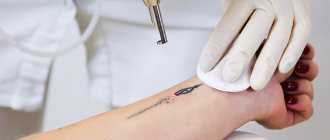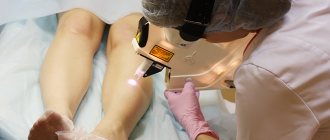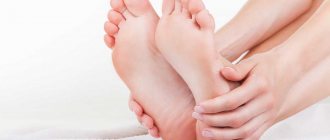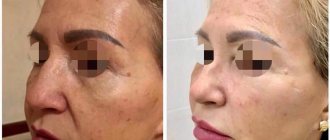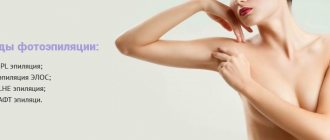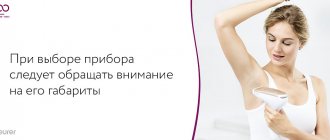Forget about shaving, sugaring or waxing for a long time and get smooth skin without irritation - this is possible with the help of photoepilation. The procedure quickly gained popularity as it is painless, safe and suitable for all skin tones. If you have long wanted to delve into this issue, this information is for you.
In this article:
Photoepilation: what it is and how it works Photoepilation and color types Description of the procedure What happens after the session How many procedures are needed Skin care between sessions Contraindications How long does hair not grow
Features of photoepilation
Photoepilation can be carried out in three different types:
- Elos – hair removal
This is a type of depilation that is performed on hair of different shades. The essence of the procedure is that the hairs are exposed to a light beam with an intensity of 45 J, and the bipolar radio frequency consolidates the effect. To avoid burning the skin, gel is first applied to it. The disadvantages of elos hair removal are that it is quite painful and you will have to undergo more than one session to consolidate the result.
- LHE – hair removal
During this type of photoepilation, the patient is exposed to a low-efficiency light beam (only 12 J). This does not cause burns to the skin, so no protective gel is used. The procedure is based on infrared radiation penetrating through the hair surface to the follicle and destroying the bulb. The advantage of the method is that unwanted vegetation is removed from a large area of the body, while little time is spent.
- IPL – hair removal
This type of hair removal involves exposure to high-intensity flashes of light with a power of up to 60 J. It is necessary to apply a special gel to prevent burns. The disadvantage of the procedure is that it does not remove gray hairs, and is also not applicable in the intimate area.
Side effects
Destruction of hair follicles during photoepilation occurs due to exposure to thermal energy. Therefore, with high skin sensitivity, the risk of burns increases. Most often it appears due to incorrect selection of light intensity or equipment malfunction. If the device is working properly, a burn may occur due to depilation at the wrong time: after prolonged exposure to the sun or during irritation.
Before doing photoepilation on large areas of the body, you should observe how the skin behaves after it. An allergic reaction to light flashes or post-epilation care products is possible.
When working with a photoepilator, you must take care of protecting your eyesight - light flashes impair vision.
Preparation for photoepilation
Photoepilation: “before” and “after” photos
Preparing for photoepilation involves undergoing an examination. First of all, you need to visit a dermatologist, who will not only examine the condition of the skin, but also identify possible contraindications. In addition, you need to determine your skin type. Next comes a consultation with a cosmetologist who will select the most effective and safe type of procedure in each specific case.
Stages of preparation for photoepilation:
- For 14 days, you should avoid tanning on certain areas of the skin (this also applies to solariums), stop taking antibiotics, tranquilizers or steroids (during photoepilation, the effects of such drugs are enhanced, which can cause significant damage to health)
- three days in advance, in the area where the manipulation will be carried out, all hairs are shaved off with a regular razor (for the intimate area or under the arms, this must be done 48 hours before exposure to light waves)
- On the day of photoepilation, you should refuse cosmetics and also not use moisturizing or nourishing creams.
Do I need to remove hair before epilation?
When preparing, you need to take into account that the light pulse during photoepilation affects the melanin contained in the hair, so it cannot be completely removed. The recommended hair length for this procedure is at least 1 mm, but not more than 4 mm.
If the length is less than 1 mm, then the impulse will have nothing to transfer its energy to, and the procedure will be ineffective.
With a length of more than 4 mm, the energy received from the pulse will be directed to destroying the hair, not the bulb. In this case, the result is also not achieved.
How is photoepilation performed?
For some, one photoepilation procedure is enough to get rid of unwanted hair. But more often it is carried out in courses of several procedures to achieve a longer lasting effect and better results. On average, up to seven procedures will be required, which are carried out at intervals of at least 7 days. This depends on the skin tone and hair structure, which is determined by the cosmetologist.
Sometimes it happens that black hair begins to fall off already in the second session, but those with light brown hair will notice the effectiveness and efficiency of the procedure only after completing the full course. On average, 14 days after photoepilation, 75% of the treated area of skin disappears in girls with dark hair, and about 50% in blondes. This is due to the fact that fair-haired or fair-skinned girls have less melanin, which is why several more procedures will be required.
Consumer Reviews
Those who have already experienced the delights of photoepilation note the quick and lasting effect, for which it is worth enduring the pain.
Feelings: of course, the procedure is not pleasant, there is a burning sensation from photo flashes, but these are short-term flashes, there is time to rest. At the same time, the armpit area is quite tolerable, over time it even stopped reacting, the bikini area - there are very sensitive places when it actually shuddered, but I think that all this is tolerable, fast and the result is worth it. After the first session, a few days later the hairs began to fall out in clumps (I was told not to shave so that the result could be seen) and grow extremely slowly. At first I went for photoepilation once every one to one and a half months, then less and less, my hair practically stopped growing. For me it was simply magical: the irritation went away, the skin brightened in the areas where I shaved, and the unpleasant darkening that I was embarrassed about disappeared. Armpits and bikini became smooth. Overall, I couldn't stop looking at it. And I couldn’t be happier, because compared to how I used to have to shave once every three days and feel a constant burning sensation from irritation - for me it was just a thrill.
Valencia
https://otzovik.com/review_3028431.html
Experienced clients of beauty salons recognize the highest effectiveness of this method of combating unwanted hair.
I have done all types of hair removal and I can assure you that photoepilation is the most effective hair removal procedure!!! Smooth skin of bikini and legs without stubble and ingrown hairs, I guarantee!!! No razor, only a combination of photoepilation + wax gives an amazing result.
Consumer inessa012 shows off smooth skin after treatment
inessa012
https://irecommend.ru/content/fotoepilyatsiya-luchshe-eshche-ne-pridumali
However, this procedure is not successful for everyone.
It's been two years since I had this procedure. My cosmetologist recommended it to me. I went to a good clinic. I hadn’t read reviews on the Internet before, so I trusted the professionals. In general, it was painful, in response to my request to do less, she said: “There is no room for less, I do my face at less power.” We had a procedure for photoepilation of all legs. It was very painful, everything turned red, the pain did not stop for about a month, the marks turned into sores and became crusty. Then the scabs fell off and in some places there were scars, but mostly just pigment stripes. And now two years have passed, and I’m still like a striped tiger. Pants in winter, long skirts in summer, I can’t swim or sunbathe. I spent a lot of money on different whitening products. Of course, now everything is much paler than it was, but there are spots all over my legs. Before you decide to do the procedure, carefully read the reviews, listen to the advice and try one flash on your skin first. Everything is individual.
Mirella_Vinc
https://irecommend.ru/content/bolshie-oslozhneniya-ozhogi-pigentatsiya
To avoid such troubles, before visiting a cosmetologist, you should carefully read the reviews about the clinic and contraindications to the procedure.
Recovery period
Photoepilation: “before” and “after” photos
Immediately after photoepilation, a special gel or cream is applied, which significantly moisturizes the skin and prevents the development of burns. You will need to use the product after the procedure, it will contribute to a speedy recovery. In addition, it is necessary to maintain water balance, since a large amount of moisture is lost as a result of manipulation.
After photoepilation, it is not recommended to visit baths and sunbathe for at least 4 days. During this time, both the skin and the water balance in it are usually restored. In addition, this will avoid swelling of the treated area, its peeling and significant redness of the skin.
To prepare for the beach season, girls should undergo photoepilation in advance, starting at the end of winter. In six months you can not only remove unwanted body hair, but also significantly improve the appearance of your skin.
Advantages
Photoepilation: “before” and “after” photos
Photoepilation has many advantages:
- painless method with high efficiency
- the ability to remove unwanted hair, regardless of hair shade (the only exception is gray hair)
- minimal risk of infection as it is a non-invasive method
- low risk of burns and virtually no unpleasant consequences
Disadvantages of photoepilation
Despite its advantages, the photoepilation method also has its disadvantages, which are as follows:
- owners of blond hair will have to undergo more sessions than girls with dark hair (it's all about melanin, which blondes have less of)
- on tanned skin, photoepilation can cause burns or unwanted pigmentation (low qualifications of the technician or the equipment itself can also cause burns)
- The result of the procedure is not visible immediately, at least after two weeks
- if you do not follow the specialist’s recommendations regarding the recovery period, then peeling, swelling and redness of the area cannot be avoided
The effectiveness of photoepilation
Photoepilation: “before” and “after” photos
Photoepilation is currently one of the most effective and gentle methods of removing unwanted vegetation. Scientists from all over the world have conducted a lot of research and proven that the effectiveness and efficiency of the procedure remains for many years. On average, hairs do not grow back for at least two years, but it all depends on the individual characteristics of the body.
Number of sessions
It is impossible to accurately predict the effectiveness of all sessions. It all depends on the individual’s body, his hair and the condition of the treated area. According to statistics, after the first procedure, 20 percent of hair disappears permanently.
Important ! Those bulbs that did not have time to enter the active phase are not affected, which means that the hair will soon grow again. Therefore, careful diagnosis is required before the procedure.
A thorough diagnosis will not be superfluous
Also, the following factors can influence the number of procedures and quality:
- device power;
- device parameters;
- doctor's experience.
It is recommended to conduct sessions six to ten times. Due to the fact that hair falls out for about two or three more weeks, you should maintain an interval of one month after the first procedure, and then watch as new hair grows.
Important ! After a course of procedures, the patient’s hair stops growing for three to five years.
It is necessary to follow the principles of procedures and intervals between them
Contraindications
Like any cosmetic procedure, photoepilation has its contraindications.
- The procedure can be carried out only 2-3 weeks after sea tanning or visiting a solarium. During this time, the skin is restored and burns do not occur.
- It is not used for people with diabetes mellitus, with heart pathologies, during exacerbation of chronic diseases, or with malignant neoplasms (especially on the skin).
- The procedure is contraindicated for pregnant and lactating women, as well as for those who have wounds, abrasions or tattoos at the site of photoepilation.
Possible consequences
Photoepilation and its features
Side effects from photoepilation:
- the appearance of pigment spots at the site of exposure to light pulses
- burns and their further scarring
- peeling, swelling, bruising and significant redness of the light-treated area
- allergic manifestations
- increase in body temperature
These side effects can be avoided if photoepilation is carried out by an experienced specialist and only with high-quality equipment. Sometimes allergies and dermatitis on the skin can also occur due to the individual characteristics of the body. To avoid this, you should follow the specialist’s recommendations regarding preparation for the procedure.
Alternative Methods
After photoepilation, side effects can occur only in two cases: the presence of a contraindication, as well as an incorrectly selected photoepilator mode and its intensity. People with sensitive skin should choose a different method for removing unwanted hair.
Alternative hair removal methods:
- regular razor
- sugaring
- waxing
Regardless of skin sensitivity, there are no side effects.
How many procedures are needed?
To completely remove hair, you must undergo a course of procedures. They are held approximately once every 3-4 weeks. This is not without reason, because this is exactly how long the life cycle of one hair takes. Thus, by the next procedure, the dormant follicles are activated, and it is the pigment of these new hairs that must be destroyed by photoepilation.
The procedure is repeated until all the hair makes itself felt and is destroyed by light pulses. Total – at least 5 procedures. If you have coarse and densely growing hair, up to 10 treatments may be required. You will get a really noticeable result after the third session - your hair will be twice as small.
